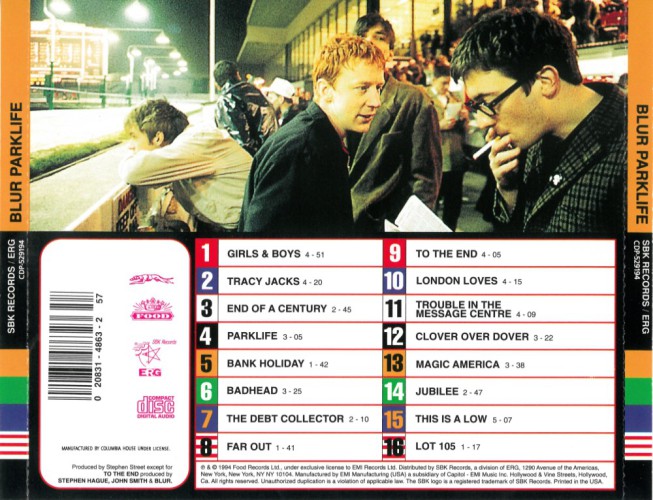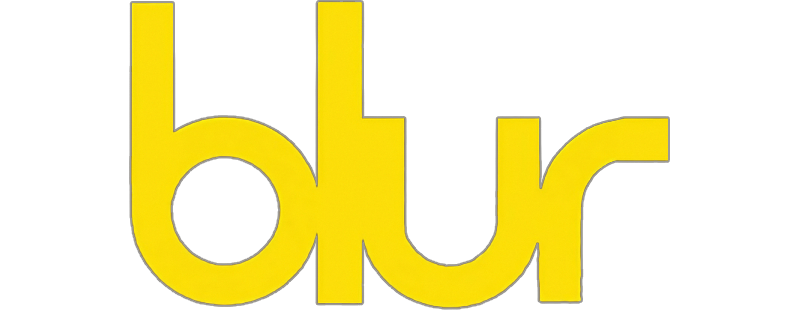Track List
01) Girls & Boys
02) Tracy Jacks
03) End of a Century

04) Parklife

05) Bank Holiday
06) Badhead
07) The Debt Collector
08) Far Out
09) To the End

10) London Loves
11) Trouble in the Message Centre
12) Clover Over Dover
13) Magic America
14) Jubilee
15) This Is a Low
16) Lot 105
01) Girls & Boys
02) Tracy Jacks
03) End of a Century
04) Parklife
05) Bank Holiday
06) Badhead
07) The Debt Collector
08) Far Out
09) To the End
10) London Loves
11) Trouble in the Message Centre
12) Clover Over Dover
13) Magic America
14) Jubilee
15) This Is a Low
16) Lot 105
4:50
4:20
2:45
3:05
1:42
3:25
2:10
1:41
4:04
4:15
4:09
3:22
3:38
2:47
5:07
1:18
Data Complete 80%
Total Rating
Total Rating
![]() (1 users)
(1 users)
Back Cover
CD Art
3D Case
3D Thumb
3D Flat
3D Face
3D Spine
First Released
![]() 1994
1994
![]() Alternative Rock
Alternative Rock
![]() Poignant
Poignant
![]() Britpop
Britpop
![]() ---
---
![]() Medium
Medium
![]() Album
Album
![]() 0 copies
0 copies
Album Description
Available in:

Parklife es el tercer álbum de la banda, lanzado el 25 de abril de 1994 a través del sello discográfico Food Records.
Producido por Stephen Street que se consolidó como arquitecto sonoro de Blur en una producción se caracteriza por ser clara y brillante, con guitarras siempre presentes pero sin opacar arreglos de metales, cuerdas o sintetizadores y grabado principalmente en Maison Rouge Studios (Fulham, Londres) y Town House Studios (Shepherd’s Bush, Londres), a lo largo de 1993. En cuanto a la formación se mantenía intacta.
Después del tibio éxito del disco anterior, Blur aún no era un grupo de masas. Sin embargo, el disco les había devuelto la confianza y les dio una dirección artística clara: defender lo británico frente al dominio cultural del grunge. Parklife es el disco que consagró el britpop como movimiento. Suena como una antología de la cultura pop británica del siglo XX, pasada por el filtro irónico de Albarn y las guitarras inventivas de Coxon. Juega con una paleta sonora amplísima: pop orquestal, punk, cabaret, electrónica primitiva y baladas melódicas.
Entre sus canciones destacan "Girls & Boys" single de adelanto con ritmos inspirados en la música de club, sátira sobre el hedonismo vacacional británico en la Costa del Sol que fue un éxito inmediato y "Parklife" pieza central del álbum, con el actor Phil Daniels recitando un monólogo sobre la vida cotidiana.
Fue aclamado casi unánimemente por la crítica y la prensa lo celebró como el disco que definía la nueva música británica. NME lo nombró disco del año en 1994. Fue un éxito rotundo en ventas alcanzando el nº 1 en Reino Unido y vendiendo más de 2 millones de copias. Ganó el Brit Award a Mejor Álbum Británico en 1995.
El título Parklife surgió de la idea de Albarn de que “los parques son un microcosmos de la sociedad británica”. La estética visual del disco (con galgos en la portada) reforzaba la idea de lo británico cotidiano llevado al arte pop.
Marcó el salto al estrellato de la banda, estableció a Damon Albarn como la voz de una generación británica, consolidó a Blur como líderes del britpop, antes incluso de su famosa rivalidad con Oasis (muchos críticos consideran Parklife el álbum definitorio del britpop, más aún que Definitely Maybe de Oasis, porque fue el primero en llevar esa identidad al mainstream) y sentó las bases para que los años 1994-1997 fueran el periodo más exitoso del grupo.

User Album Review
Before Damon Albarn became every inch the multi-faceted post-modern Renaissance man, Blur was his sole passion and Parklife from 1994 remains their finest work. Recorded between November 1993 and January 1994 in London, Parklife captured the zeitgeist in a manner few other albums have.
Their second album after the group's wholehearted embracing of British popular culture (the critically-lauded, commercially underperforming Modern Life Is Rubbish the first), with its Walthamstow dog track-adorned sleeve, Parklife was where Britpop began, with its series of well-crafted songs that re-tooled the writing of Ray Davies and Paul Weller for the 90s. Albarn – supported ably by guitarist Graham Coxon, bassist Alex James and drummer Dave Rowntree – mapped out Blur’s territory as cultural tourists: chroniclers of the mores and foibles of the modern world, be it presciently with gender confusion, binge-drinking and the genesis of chav culture (all on “Girls And Boys”), pre-millennial tension and growing older (“End Of A Century”) or the renaissance of England’s capital city (“London Loves”, “Parklife”). Even the album’s nonsense (“The Debt Collector”, or James’ Syd Barrett tribute, “Far Out”) serves to bolster the flow. However, it is the touching closer “This Is A Low” which steals the show, taking something as quintessential parochial as the shipping forecast and turning it into compelling, poetic pop.
Around the same period, Oasis released their first material. Soon, Britpop would have its Beatles and its Stones, with endless column inches scrutinising their lives and rivalries. Before all that, and regardless of what it all became, we still have this exemplary record.
External Album Reviews
None...
User Comments


Available in:
Parklife es el tercer álbum de la banda, lanzado el 25 de abril de 1994 a través del sello discográfico Food Records.
Producido por Stephen Street que se consolidó como arquitecto sonoro de Blur en una producción se caracteriza por ser clara y brillante, con guitarras siempre presentes pero sin opacar arreglos de metales, cuerdas o sintetizadores y grabado principalmente en Maison Rouge Studios (Fulham, Londres) y Town House Studios (Shepherd’s Bush, Londres), a lo largo de 1993. En cuanto a la formación se mantenía intacta.
Después del tibio éxito del disco anterior, Blur aún no era un grupo de masas. Sin embargo, el disco les había devuelto la confianza y les dio una dirección artística clara: defender lo británico frente al dominio cultural del grunge. Parklife es el disco que consagró el britpop como movimiento. Suena como una antología de la cultura pop británica del siglo XX, pasada por el filtro irónico de Albarn y las guitarras inventivas de Coxon. Juega con una paleta sonora amplísima: pop orquestal, punk, cabaret, electrónica primitiva y baladas melódicas.
Entre sus canciones destacan "Girls & Boys" single de adelanto con ritmos inspirados en la música de club, sátira sobre el hedonismo vacacional británico en la Costa del Sol que fue un éxito inmediato y "Parklife" pieza central del álbum, con el actor Phil Daniels recitando un monólogo sobre la vida cotidiana.
Fue aclamado casi unánimemente por la crítica y la prensa lo celebró como el disco que definía la nueva música británica. NME lo nombró disco del año en 1994. Fue un éxito rotundo en ventas alcanzando el nº 1 en Reino Unido y vendiendo más de 2 millones de copias. Ganó el Brit Award a Mejor Álbum Británico en 1995.
El título Parklife surgió de la idea de Albarn de que “los parques son un microcosmos de la sociedad británica”. La estética visual del disco (con galgos en la portada) reforzaba la idea de lo británico cotidiano llevado al arte pop.
Marcó el salto al estrellato de la banda, estableció a Damon Albarn como la voz de una generación británica, consolidó a Blur como líderes del britpop, antes incluso de su famosa rivalidad con Oasis (muchos críticos consideran Parklife el álbum definitorio del britpop, más aún que Definitely Maybe de Oasis, porque fue el primero en llevar esa identidad al mainstream) y sentó las bases para que los años 1994-1997 fueran el periodo más exitoso del grupo.
User Album Review
Before Damon Albarn became every inch the multi-faceted post-modern Renaissance man, Blur was his sole passion and Parklife from 1994 remains their finest work. Recorded between November 1993 and January 1994 in London, Parklife captured the zeitgeist in a manner few other albums have.
Their second album after the group's wholehearted embracing of British popular culture (the critically-lauded, commercially underperforming Modern Life Is Rubbish the first), with its Walthamstow dog track-adorned sleeve, Parklife was where Britpop began, with its series of well-crafted songs that re-tooled the writing of Ray Davies and Paul Weller for the 90s. Albarn – supported ably by guitarist Graham Coxon, bassist Alex James and drummer Dave Rowntree – mapped out Blur’s territory as cultural tourists: chroniclers of the mores and foibles of the modern world, be it presciently with gender confusion, binge-drinking and the genesis of chav culture (all on “Girls And Boys”), pre-millennial tension and growing older (“End Of A Century”) or the renaissance of England’s capital city (“London Loves”, “Parklife”). Even the album’s nonsense (“The Debt Collector”, or James’ Syd Barrett tribute, “Far Out”) serves to bolster the flow. However, it is the touching closer “This Is A Low” which steals the show, taking something as quintessential parochial as the shipping forecast and turning it into compelling, poetic pop.
Around the same period, Oasis released their first material. Soon, Britpop would have its Beatles and its Stones, with endless column inches scrutinising their lives and rivalries. Before all that, and regardless of what it all became, we still have this exemplary record.
External Album Reviews
None...
User Comments

No comments yet...


